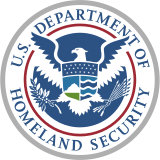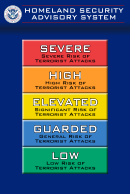- Homeland Security Act
-
Homeland Security Act of 2002 
Full title To establish the Department of Homeland Security, and for other purposes. Acronym HSA Enacted by the 107th United States Congress Effective November 25th, 2002 Citations Public Law 107-296 Stat. 117 Stat. 745 Codification U.S.C. sections created 17 U.S.C. sections substantially amended 150 sections amended - Introduced in the House as H.R. 5005 by House of Representative on June 24, 2002
- Passed the House of Representatives on November 19th, 2002 ()
- Passed the Senate on November 25th, 2002 (Unanimous vote)
- Signed into law by President George W. Bush on November 25th, 2002
Major amendments Relevant Supreme Court cases None The Homeland Security Act (HSA) of 2002, (Pub.L. 107-296, 116 Stat. 745, enacted November 25, 2002), 116 Stat. 2135[1] was introduced in the aftermath of the September 11 attacks and subsequent mailings of anthrax spores.[2][3] The HSA was cosponsored by 118 members of Congress.[4] It was signed into law by President George W. Bush in November 2002.[5][6]
HSA created both the United States Department of Homeland Security and the new cabinet-level position of Secretary of Homeland Security. It is the largest federal government reorganization since the Department of Defense was created via the National Security Act of 1947 (as amended in 1949). It also includes many of the organizations under which the powers of the USA PATRIOT Act are exercised.
Contents
Background
The new department assumed a large number of services, offices and other organizations previously conducted in other departments, such as the Customs Service, Coast Guard, and U.S. Secret Service. It superseded, but did not replace, the Office of Homeland Security, which retained an advisory role. The Homeland Security Appropriations Act of 2004 provided the new department its first funding. A major reason for the implementation of HSA is to ensure that the border function remains strong within the new Department.[7]
The Act is similar to the Intelligence Reform and Terrorism Prevention Act (IRTPA) in reorganizing and centralizing Federal security functions to meet post–Cold War threats and challenges.[2] Like IRTPA, there are some inherent contradictions in the bill not solved by reorganization. These reflect compromises with other committees needed to secure passage, but the result is at times inconsistent or conflicting authorities. For example, the Act identifies the Department of Homeland Security's (DHS) first responsibility as preventing terrorist attacks in the United States; but, the law's language makes clear that investigation and prosecution of terrorism remains with the FBI and assigns DHS only an analytical and advisory role in intelligence activities.[1] Similarly, with Critical Infrastructure Protection (CIP), which relates to the preparedness and response to serious incidents, the Act gave DHS broad responsibility to minimize damage but only limited authority to share information and to coordinate the development of private sector best practices.
Establishments
The Homeland Security Act of 2002 is the foundation for many other establishments, including:[2]
- the Department of Homeland Security, which is headed by the Secretary of Homeland Security
- an established Directorate for Information Analysis and Infrastructure Protection within the Department of Homeland Security, which is headed by the Under Secretary for Information Analysis and Infrastructure Protection.
- the Critical Infrastructure Information Act of 2002
- the Cyber Security Enhancement Act of 2002
Titles
The Homeland Security Act of 2002 documented under Public Law is divided into 17 titles that establishes the Department of Homeland Security and other purposes. Each title is broken down into several sections, summarized below.[1][2][8]
- 1. Department of Homeland Security
- Title I consists of three sections that establish the Department of Homeland Security, which carries out several missions that comply with the United States Code.
- 2. Information Analysis And Infrastructure Protection
- Title II consists of nineteen sections. It is headed by the Under Secretary and used to access, receive and analyze law enforcement information, intelligence information, and other information from federal, state, and local government agencies for further use towards the prevention of terrorist acts.
- 3. Science And Technology In Support of Homeland Security
- Title III consists of thirteen sections. It is described as a plan to develop national policy and strategic plans to develop countermeasures for chemical, biological, radiological, nuclear and other emerging terrorist threats. It also establishes, conducts, and administers primary research and development.
- 4. Directorate Of Border And Transportation Security
- Title IV consists of forty-eight sections and regulates what comes in out of United States territory in an effort to prevent terrorists and instruments of terrorism. This is done generally by securing the borders, territorial waters, ports, terminals, waterways, and air, land, and sea transportation systems of the United States, including managing and coordinating governmental activities at ports of entry.
- 5. Emergency Preparedness and Response
- Title V consists of nine sections and it helps to ensure the response time and preparedness of providers for terrorist attacks, major disasters and other emergencies. In addition, it establishes standards, joint exercises and trainings and providing funds to the United States Department of Energy and the Environmental Protection Agency.
- 6. Treatment of Charitable Trusts For Members Of The Armed Forces Of The United States And Other Governmental Organizations
- Title VI consists of one section which, through several requirements, designates the late CIA officer Johnny Michael Spann as a trust fund for distribution towards surviving spouses, children, or dependent parents, grandparents, or siblings of Government related service members.
- 7. Management
- Title VII consists of six sections which is headed by the Under Security to manage the budget, appropriations, expenditures of funds, accounting, and finance, human resources, information technology, and procurement of the Departments.
- 8. Coordination With Non-Federal Entities; Inspector General; United States Secret Service; Coast Guard; General Provisions
- Title VIII consists of fifty-three sections that establishes an Office for State and Local Governments to oversee and coordinate Departmental programs for and relationships with State and local governments.
- 9. National Homeland Security Council
- Title IX consists of six sections which establishes a "Homeland Security Council" within the Executive Office of the President. This Council functions as an advisor to the President.
- 10. Information Security
- Title X consists of seven sections regarding the establishment of several divisions of Information Security. This title and its subchapter provides tactics and mechanisms for protecting federal information and preserve information security. In addition, it also establishes set standards, responsibilities, authorities and functions, the various definitions in information security, and an annual independent evaluation.
- 11. Department of Justice Divisions
- Title XI consists of sixteen sections which details the powers and duties of the Secretary, the Under Secretary, and the Attorney General.
- 12. Airline War Risk Insurance Legislation
- Title XII consists of four sections which details air carrier liability for Third Party claims arising out of acts of terrorism, extension of insurance policies, correction of reference, and reports.
- 13. Federal Workforce Improvement
- Title XIII consists of thirteen sections which in several chapters details and establishes Chief Human Capital Officers and it's council.
- 14. Arming Pilots Against Terrorism
- Title XIV consists of seven sections which contains the establishment of a program to deputize volunteer pilots of air carriers providing passenger air transportation or intrastate passenger air transportation as Federal law enforcement officers to defend the flight decks of aircraft of such air carriers against acts of criminal violence or air piracy.
- 15. Transition
- Title XV consists of ten sections establishing the 12-month period beginning on the effective date of this Act. It consists of the definitions, reorganization plan, plan elements, and modification of plans.
- 16. Corrections To Existing Law Relating To Airline Transportation Security
- Title XVI consists of three sections that establish retention of security sensitive information authority at the Department of Transportation, increase civil penalties, and allow United States citizens and United States nationals as screeners.
- 17. Conforming And Technical Amendments
- Title XVII consists of seven sections that amend or alter several acts and amendments of the United States such as the Inspector General Act of 1978 and Title 5 of the United States Code
Department of Homeland Security
Main article: Department of Homeland Security Seal of the United States Department of Homeland Security Seal.
Seal of the United States Department of Homeland Security Seal.
The United States Department of Homeland Security (DHS), formed November 25, 2002 through the Homeland Security Act, is a Cabinet department composed of several different divisions that work to protect the United States from terrorists and natural disasters. It was created as a response to the terrorists attacks that occurred on September 11th, 2001.[1] The Department of Homeland Security manages the Emergency Preparedness and Response Directorate. The directorate helps fulfill the Department's overarching goal: to keep America safe from terrorist attacks.[9] The Department also works to enhance preparedness and response efforts and to integrate these efforts with prevention work.[9] With the Homeland Security Act there are several provisions that identify the specific duties for the EP&R Directorate.
Provisions
The Homeland Security Act contains several provisions that identify specific duties for the EP&R Directorate.[9] Title V and Title II outline the way the department ensures the following: that the use of intelligence and its own threat analysis of terrorist capabilities are intended to distribute funds to those areas where the terrorist threat is greatest; and that states provide the Federal Government with their Emergency Response Plans so that the department can coordinate priorities regionally and nationally.[9][10]
Establishments Under the Homeland Security Department
- Ready.gov which was conceived in March 2002 and launched in February 2003
- National Incident Management System which was established in March 2004
- National Response Plan (NRP) which was created in December 2004
- National Cyber Security Division (NSCD)
- E-Verify
Criticism
The Homeland Security Act has been criticized[by whom?] for forbidding the Citizen Corps program called Operation TIPS (Terrorism Information and Prevention System). This criticism is regarded to be from the fear that the rejection of TIPS may contain setbacks to civil liberties protections such as the right to privacy and obstructing public access to information.[11]
According to activist Nancy Talanian, the established Homeland Security Act exacerbates three issues in the United States:[12]
- Reduced Privacy
- Increased Government Secrecy
- Strengthened government protection of special interests
Legislative Information
See also
- United States Department of Homeland Security
- Homeland Security Grant Program
- Homeland Security Advisory System
- National Security Act of 1947
- Intelligence Reform and Terrorism Prevention Act
- FEMA, established by the Homeland Security Department
- Presidential Directive
- Immigration Act of 1924
- Homeland Security Appropriations Act
- September 11th, 2001
- Terrorism in the United States
References
- ^ a b c d "The Homeland Security Act of 2002 -- A Summary". Martindale.com. May 15, 2003. http://www.martindale.com/members/Article_Atachment.aspx?od=66596&id=8822&filename=asr-8824.pdf. Retrieved 2010-11-15.
- ^ a b c d "Homeland Security Act of 2002 Summary". Third World Traveler. http://www.thirdworldtraveler.com/Homeland_Security/HomelandSecurity_Summary.html. Retrieved 2010-10-26.
- ^ "Legislative Updates". Office of Legislative Policy And Analysis. http://olpa.od.nih.gov/legislation/107/publiclaws/hmlndsecrty.asp. Retrieved 2010-11-02.
- ^ "Bill Summary & Status". (THOMAS) Library of Congress. http://thomas.loc.gov/cgi-bin/bdquery/z?d107:HR05005:@@@P. Retrieved 2010-10-30.
- ^ "Homeland Security Act". rationalevolution.net. http://rationalrevolution.net/war/homeland_security_act.htm. Retrieved 2010-10-26.
- ^ "Bush signs Homeland Security bill". CNN. http://archives.cnn.com/2002/ALLPOLITICS/11/25/homeland.security/. Retrieved 2010-11-01.
- ^ "Homeland Security Act of 2002". Policy Almanac. http://www.policyalmanac.org/world/archive/homeland_defense.shtml. Retrieved 2010-11-15.
- ^ "PUBLIC LAW 107–296—NOV. 25, 2002". Department of Homeland Security. http://www.dhs.gov/xlibrary/assets/hr_5005_enr.pdf. Retrieved 2010-10-30.
- ^ a b c d "Hearing On Response To Terrorism: How Is The Department Of Homeland Security Improving Our Capabilities?". U.S. House of Representatives Committee. http://www.access.gpo.gov/congress/house. Retrieved 2010-11-07.
- ^ "Homeland Security Act of 2002". http://lawbrain.com/wiki/Homeland_Security_Act_of_2002#Title_V:_Emergency_Preparedness_and_Response. Retrieved 2010-11-07.
- ^ "The Homeland Security Act". PBS. http://www.pbs.org/newshour/indepth_coverage/terrorism/homeland/securityact.html. Retrieved 2010-10-26.
- ^ "The Homeland Security Act: The Decline of Privacy; the Rise of Government Secrecy". Bill of Rights Defense Committee. http://www.bordc.org/resources/hsasummary.pdf. Retrieved 2010-10-30.
External links
Wikimedia Foundation. 2010.


